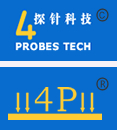| Resistivity,
Rho, is a particularly important semiconductor parameter because
it can be related directly to the impurity content of a sample;
The four point probe is the apparatus typically used to determine
bulk resistivity.
The mobility of the carriers depends upon temperature,
crystal defect density, and ALL impurities present. Hall Effect
Measurements can determine the mobility of the carriers in
a given sample to allow for more accurate dopant concentration
measurements, but Hall measurements are usually destructive
to the sample.
The four point probe contains four thin collinearly placed
tungsten wires probes which are made to contact the sample
under test. Current I is made to flow between the outer probes,
and voltage V is measured between the two inner probes, ideally
without drawing any current. If the sample is of semi-infinite
volume and if the interprobe spacings are s1= s2 = s3 = s,
then it can be shown that the resistivity of the semi-infinite
volume is given by
Rhoo =(2 Pi s)V/I (1)
The subscription in the preceding equation indicates the
measured value of the resistivity and is equal to the actual
value, Rho, only if the sample is of semi-infinite volume.
Practical samples, of course, are of finite size. Hence, in
general, Rho != Rhoo. Correction factors for six different
boundary configurations have been derived by Valdes.(1) These
show that in general if l, the distance from any probe to
the nearest boundary, is at least 5s, no correction is required.
For the cases when the sample thickness is <= 5s, we can
compute the true resistivity from
Rho = a 2 Pi s V/I = a Rhoo (2)
where a is the thickness correction factor which is plotted
on page GT-2.
From an examination of the plot we see that for values of
t/s >= 5 the corresponding value of a is unity. Thus for
samples whose thickness is at least 5 times the probe spacing,
no correction factor is needed. Typical probe spacings are
25-60 mils and the wafers used in most cases are only 10-20
mils, so unfortunately we cannot ignore the correction factor.
Looking again at the plot, however, we see that the curve
is a straight line for values of t/s <= 0.5. Since it is
a log-log plot the equation for the line must be of the form
a = K (t/s)^m (3)
where K is the value of a at (t/s) = 1, and m is the slope.
Inspection of the plot shows that in this case m = 1. K is
determined to be 0.72 by extrapolating the linear region up
to the value at (t/s) - 1. (The exact value can be shown to
be 1/(2 ln 2).) Hence for slices equal to or less than one
half the probe spacing
a = 0.72 t/s
When substituted into the basic equation we get:
Rho = a 2 Pi s V/I = 4.53t V/I , (t/s) <= 0.5 (4)
All samples we will be using in the lab satisfy the one-
half relationship so we can use the above formula to determine
Rho. We will perform resistivity measurements on the starting
material for each experiment. The value of r obtained will
be referred to as the bulk resistivity, and the units are
Ohm-cm.
If both sides of Equation (4) are divided by t we get
Rs = Rho/t = 4.53 V/I for t/s <= 0.5 (5)
which we refer to as sheet resistance. When the thickness
t is very small, as would be the case for a diffused layer,
this is the preferred measurement quantity. Note that Rs is
independent of any geometrical dimension and is therefore
a function of the material alone. The significance of the
sheet resistance can be more easily seen if we refer to the
end-to- end resistance of a rectangular sample. From the familiar
resistance formula
R = Rho l/wt (6)
we see that if w = l (a square) we get
R = Rho/t = Rs.
Therefore, Rs may be interpreted as the resistance of a
square sample, and for this reason the units of Rs are taken
to be ohms-per-square or ohm/sq. Dimensionally this is the
same as ohms but this notation serves as a convenient reminder
of the geometrical significance of sheet resistance.
So far in our discussion of resistivity measurements we
have assumed that the size of our sample is large compared
to the probe spacing so that edge effects could be ignored.
This is usually the case for the bulk resistivity measurement.
However, our sheet resistance measurements will be made on
a "test area" on our wafer and the test area dimensions
(nominally 2.9 by 5.8mm) are not that large compared to the
probe spacing (25 mils). In order to get accurate measurements
we will need to correct for the edge effects.
In general then
Rs = C V/I (7)
where C is the correction factor.
Note that for d/s > 40, C = 4.53, the value we had as
the multiplier in Equation (5).
References
1.Valdes, L. B., "Resistivity Measurements on Germanium
for Transistors", in Proceedings of the IRE, February
1954, p. 420-427
2.Smits, F. M., "Measurements of Sheet Resistivity with
the Four-Point Probe", BSTJ, 37, p. 371 (1958). (Same
as BT Monograph, 3894, Part 2).
Courtesy of:
ECE344: Theory and Fabrication of Integrated Circuits
Electrical and Computer Engineering
University of Illinois - Urbana/Champaign
|

